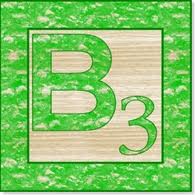Dr. Weeks Comment: No news here. My friend and mentor, the late and great Abram Hoffer demonstrated this important attribute of niacin (vitamin B3) in the early 1960’s. His work was ignored because, well, because no money can be made from the selling of a naturally occurring supplement, whereas billions can be “earned” by selling a patented drug to lower cholesterol. In life, truth will out. And so today, more than 50 years later, Niacin is in the ascendancy but wait! What happens now? (highly predictable….) Niacin, our old friend, the reliable, cheap, safe and effective natural remedy is about to be swept aside in favor of a patented (i.e “profitable”) version, the low flush Niaspan.
For those of you new to this site, I urge you to consider the following caveat: In modern medicine, if the solution to a medical problem is cheap and readily available, it is stigmatized in favor of a profitable (patentable) option which, itself is typically expensive and fraught with deleterious side-effects. Otherwise stated: “If there is no money in the solution, there is no problem.” – as in the case of homocysteine.
Prescription-Grade Niacin May Be More Effective Than Cholesterol-Lowering Drugs
 New findings presented at the annual scientific meeting of theAmerican Heart Association (AHA) and published in the The New England Journal of Medicine show that prescription-grade niacin may be more effective in lowering cholesterol than the popular cholesterol-lowering drugs Zetia and Vitorin. The 208-patient study””which was funded by Abbott Laboratories, the manufacturer of Niaspan, a prescription-grade niacin product””concluded that Niaspan lowered levels of plaque in patients’ arteries more effectively than its drug counterparts.
New findings presented at the annual scientific meeting of theAmerican Heart Association (AHA) and published in the The New England Journal of Medicine show that prescription-grade niacin may be more effective in lowering cholesterol than the popular cholesterol-lowering drugs Zetia and Vitorin. The 208-patient study””which was funded by Abbott Laboratories, the manufacturer of Niaspan, a prescription-grade niacin product””concluded that Niaspan lowered levels of plaque in patients’ arteries more effectively than its drug counterparts.
ABSTRACT Background Treatment added to statin monotherapy to further modify the lipid profile may include combination therapy to either raise the high-density lipoprotein (HDL) cholesterol level or further lower the low-density lipoprotein (LDL) cholesterol level.
Methods We enrolled patients who had coronary heart disease or a coronary heart disease risk equivalent, who were receiving long-term statin therapy, and in whom an LDL cholesterol level under 100 mg per deciliter (2.6 mmol per liter) and an HDL cholesterol level under 50 mg per deciliter for men or 55 mg per deciliter for women (1.3 or 1.4 mmol per liter, respectively) had been achieved. The patients were randomly assigned to receive extended-release niacin (target dose, 2000 mg per day) or ezetimibe (10 mg per day). The primary end point was the between-group difference in the change from baseline in the mean common carotid intima-media thickness after 14 months. The trial was terminated early, on the basis of efficacy, according to a prespecified analysis conducted after 208 patients had completed the trial.
Results The mean HDL cholesterol level in the niacin group increased by 18.4% over the 14-month study period, to 50 mg per deciliter (P<0.001), and the mean LDL cholesterol level in the ezetimibe group decreased by 19.2%, to 66 mg per deciliter (1.7 mmol per liter) (P<0.001). Niacin therapy significantly reduced LDL cholesterol and triglyceride levels; ezetimibe reduced the HDL cholesterol and triglyceride levels. As compared with ezetimibe, niacin had greater efficacy regarding the change in mean carotid intima-media thickness over 14 months (P=0.003), leading to significant reduction of both mean (P=0.001) and maximal carotid intima-media thickness (P 0.001 for all comparisons). Paradoxically, greater reductions in the LDL cholesterol level in association with ezetimibe were significantly associated with an increase in the carotid intima-media thickness (R=-0.31, P<0.001). The incidence of major cardiovascular events was lower in the niacin group than in the ezetimibe group (1% vs. 5%, P=0.04 by the chi-square test).
0.001 for all comparisons). Paradoxically, greater reductions in the LDL cholesterol level in association with ezetimibe were significantly associated with an increase in the carotid intima-media thickness (R=-0.31, P<0.001). The incidence of major cardiovascular events was lower in the niacin group than in the ezetimibe group (1% vs. 5%, P=0.04 by the chi-square test).
Conclusions This comparative-effectiveness trial shows that the use of extended-release niacin causes a significant regression of carotid intima-media thickness when combined with a statin and that niacin is superior to ezetimibe. (ClinicalTrials.gov number, NCT00397657 [ClinicalTrials.gov] .)
Source Information
From the Cardiology Service, Walter Reed Army Medical Center (A.J.T., T.C.V., P.J.D., M.M.); and Medstar Research Institute, Washington Hospital Center (A.J.T., N.J.W.) ”” both in Washington, DC; Medco Health Solutions, Franklin Lakes, NJ (E.J.S.); Cardiac Associates, Rockville, MD (L.G.); University of Maryland Medical Center, Baltimore (M.M.); and Washington Adventist Hospital, Takoma Park, MD (M.T.).
This article (10.1056/NEJMoa0907569) was published on November 16, 2009, at NEJM.org.

